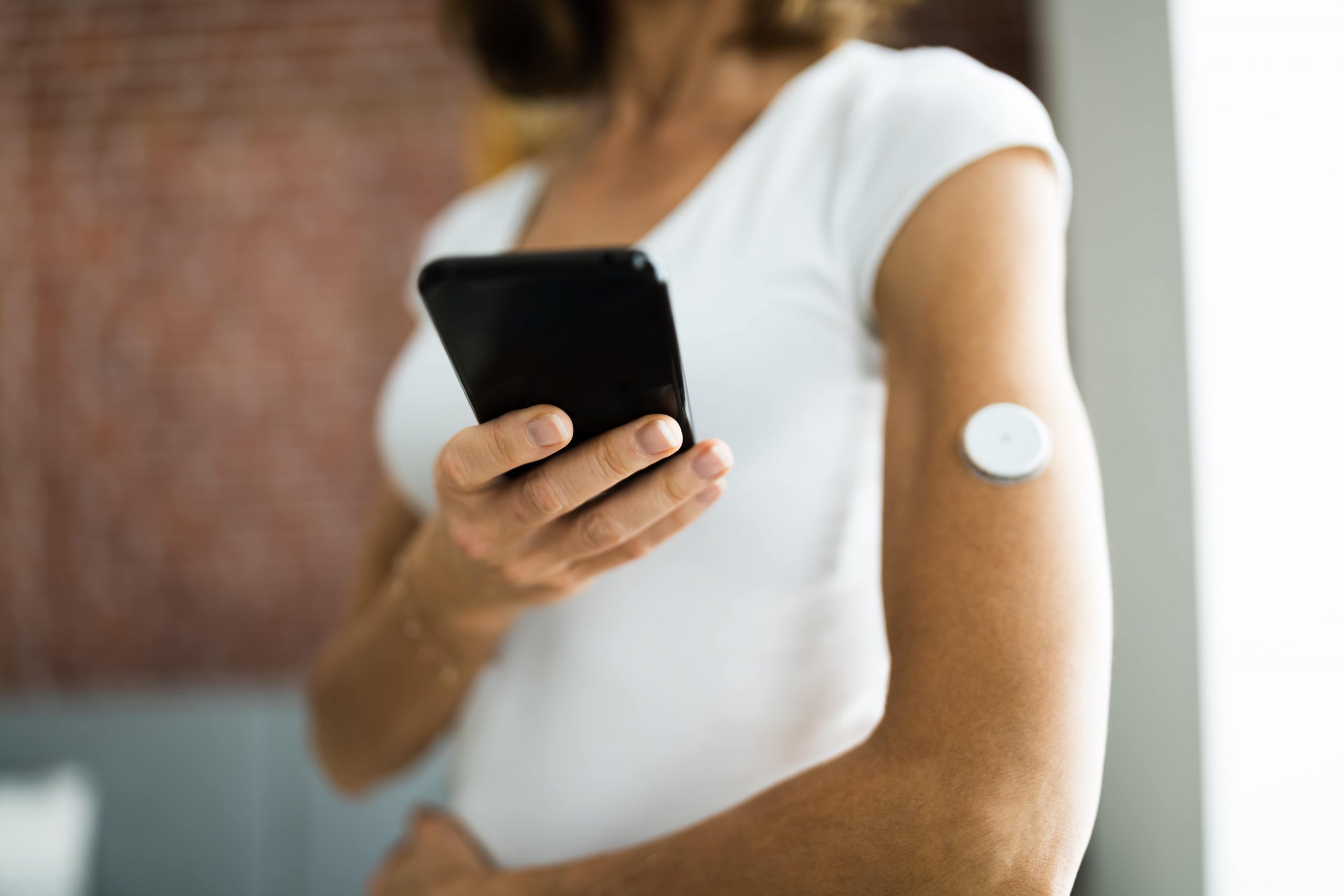Continuous glucose monitors (CGMs) are FDA-approved devices that are designed to continually monitor blood sugar levels by collecting readings automatically every 5-15 minutes. Tracking blood sugar levels in such detail allows your doctor to evaluate trends and patterns that can provide insight on how to best manage your diabetes.
For all patients, CGMs provide a granular and personalized understanding of health. A patient with normal fasting glucose or hemoglobin A1C (average glucose over 90 days) may experience constantly undulating levels of blood sugar between 65 and 180 throughout the day. These variations in blood glucose may impact fatigue, joint inflammation, and even cancer risk. Additionally, the CGM will teach people non obvious ways to control blood sugar. For example, eating an apple may send your blood sugar to 180, while slicing that apple into pieces in a bowl of yogurt will allow you to consume the same apple and keep your blood sugar below 120.
HOW CGMs WORK:
Continuous glucose monitors are inserted on your belly or arm. It contains a small thin wire that extends about 5mm below the surface of skin and into subcutaneous tissue. The sensor measures your interstitial glucose level, which is the glucose found in the fluid between the cells. The sensor tests glucose every few minutes and the information can be wirelessly transmitted to your phone. If your sugar levels are too low or too high, then the monitor will sound an alarm.
Getting a CGM
CGMs require a doctor’s prescription, and unless you have diabetes, they are not covered by insurance. One common model is the Freestyle Libre by Abbot. Sensors last 14 days and come in boxes of 2. As of February 2022, the cost of 2 sensors is $125.
Keys to Managing Blood Glucose Variability With a CGM
CGMs are a powerful driver of behavioral change including nutrition, stress, sleep and exercise (all of which significantly impact glucose). While lab tests provide helpful feedback, the real time feedback from a CGM is an incredibly effective driver of behavior. At a glance, here is how you can manage blood glucose variability with a CGM:
1 Exercise: before or after a meal (15 minutes of walking or calisthenics after a meal will blunt a glucose peak). This is particularly helpful with carb-containing meals.
2 Carbohydrate Management:
- Response to different types of carbs. Identify your personal response to a range of carbs. Oatmeal or an apple may be similar to a chocolate chip cookie in inducing glucose spikes.
- Spread daily carbs (whole grains, fruit) across meals with a goal of ½- 1 serving of carbs in any single meal (1 medium size piece of fruit, 2 slices of whole-grain bread, 1 cup of brown rice). Note, 1 apple or 2 slices of bread may create a large peak followed by an insulin surge and borderline hypoglycemia vs half an apple or 1 slice of bread may avoid the glucose peak and subsequent valley.
- Consider low carb meals focused on lean protein (chicken breast, lean turkey, non-shellfish, nonfat Greek yogurt, low-fat cottage cheese, tofu, egg whites, raw or dry roasted nuts), vegetables, and water. For some people, beans (garbanzos, black beans, pinto beans, etc.) may be added to meals without causing a large glucose elevation.
- Combine carbs which quickly elevate blood glucose with more slowly absorbed foods such as healthy unsaturated fats (raw nuts, avocado), lean protein, and fiber to soften glucose peaks.
- Consider the sequence. Salad (fiber) or protein (low fat cottage cheese) before high glycemic carbs may decrease the peak glucose response.
3 Focus on Sleep-sleep deprivation decreases insulin sensitivity and leads to a higher blood glucose response to food.
4 Stress Management -Surges in stress will elevate your blood sugar by triggering the breakdown of stored carbohydrates in your body or the production of glucose by the liver.
5 Steady Hydration with water may help blunt peaks after higher carb meals.
Glucose Troughs and Physiologic Stress Response:
It is as important to avoid glucose troughs as well as peaks. If consuming a high-carb dinner, you may be more likely to experience hypoglycemic periods while sleeping. If wearing an Oura ring or similar device that measures stress, you will see a correspondence between low glucose levels and physiologic indicators of stress (HRV- heart rate variability and Baseline Heart Rate). The heart rate variability is the time between heartbeats and is inversely correlated with stress.
Glucose Range and Inflammation:
Another benefit of avoiding glucose peaks and troughs (keeping glucose in the 75-110 range for most of the day) is a potential decrease in inflammation. People over 45 exist in a low-grade chronic inflammatory state. When this level of inflammation is decreased you may notice fewer aches and pains or an overall lower level of stiffness (like how you feel after sitting in the car for an hour).
In Conclusion
Continuous Glucose Monitors (CGMs) are effective devices used to continually measure and track blood sugar levels. This detailed monitoring performed by CGMs provides both patients and their healthcare providers with detailed information that can then be used to develop a diabetes management plan. These diabetes management plans generally include behavioral change including nutrition, stress, sleep and exercise (all of which significantly impact glucose). The goal of these changes is to decrease the occurrence of glucose troughs and peaks in order to reduce chronic inflammation and its associated symptoms.
 Dr. Bradford Rabin received his BA from Stanford University with honors in economics. In 1998, he received his MD, from Stanford University, along with the Dean’s award for Outstanding Research for nine neuroscience publications examining the biochemical pathways involved in sleep. Dr. Rabin completed his internal medicine residency at the University of California San Francisco. After his residency, he worked as a clinical instructor in the UCSF Department of Internal Medicine.
Dr. Bradford Rabin received his BA from Stanford University with honors in economics. In 1998, he received his MD, from Stanford University, along with the Dean’s award for Outstanding Research for nine neuroscience publications examining the biochemical pathways involved in sleep. Dr. Rabin completed his internal medicine residency at the University of California San Francisco. After his residency, he worked as a clinical instructor in the UCSF Department of Internal Medicine.
